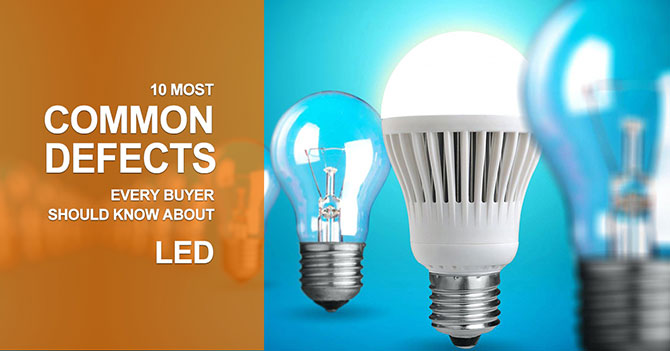Sourcing lighting products from Asia allows you to find innovative products for a reasonable cost, but even though more tempting import opportunities open in China, as well as India and Vietnam, the Quality issues would remain your #1 concern when production is outsourced.
Forewarned is forearmed! We have prepared a short list of the 10 common defects in lighting products that were found on the inspection sites of suppliers in China, India and Vietnam. Accompanying the defects, there are also some insights on possible causes and solutions, so you could keep them in mind and prevent in your production.
Let’s begin!
1) Product can’t light up
Functionality of your product is important, so make sure that it works well before it leaves the factory – select a representative amount of samples to conduct the function test and judge batch quality on your findings.
If your product can’t light up, check its light source – it might burn out, or there might be a poor contact or open circuit in the product.
Possible solutions:
- Look for any open circuits in the product and close them
- Change the light source
- Make sure that the factory uses a light up station on the production line for 100 % light up check
2) Brightness doesn’t meet requirements
When your product is just not bright enough, the problem should be searched for internally. Probably, the efficiency of the LEDs used by your supplier in the final product is not enough, or the lampshade material is wrong (ex., not transparent enough), or LED lamp beads are not suitable.
You can easily check brightness of your lights in an Integrating Sphere - a professional supplier would always have one or several of them for this purpose, or check it in the lab. In V-Trust labs we also have this testing equipment, so we would be glad to offer help if needed.
Possible solutions:
- Get your LED product checked in an integrating sphere to measure lumens
- Supervise components before applying into product (simply check purchasing information of components, and conduct a Pre-production QC on them).
- Change to higher quality LEDs, and/or to a lampshade with high transmittance
3) Light flickers when lit up
You turn on the light, and it flickers! If it is not a Disco light, then your product might have some problems… It might flicker because the LED lamp beads don’t match the LED driver, the LED driver might be broken, there might be some water drops inside the lamp / or its humidity exceeded norm. Moreover, if your supplier decided to save up some costs and assembled a poor quality LED driver, your product would end up flickering.
Possible solutions:
- Do an internal check and check the LED driver connection and other components
- Make sure the lamp is dry and humidity is within the norm
- Check if factory uses a light up station on production line for 100% light up check
4) Failed Hi-Pot test
If it fails, your lights are not safe anymore, and you should give the shipment a red light.
As a product safety measurement, Hi-Pot testing applies a high voltage (actual data depends on product insulation class I, II, III) between primary circuits and the protective grounding conductor, or between primary circuits and the insulation of the product.
So, a Failed Hi-Pot test means that your product’s insulation is destroyed / not good / not enough, or creepage distance and electrical clearance is not enough. It can allow an electric shock to occur from the grounded or conductive parts = your product is not safe to use. This is a critical issue in electrical products and thus your shipment should be rejected and rechecked for safety concerns.
Possible solutions:
- The internal structure of the product should be checked, the product needs to be disassembled and tested to identify the failed fragment
- Improve insulation, increase creepage distance and electrical clearance
- Make sure that the factory has a hi-pot test station on the production line for testing a 100% of production
5) Failed Earth Continuity test
Earth Continuity test checks resistance between the ground wire and metal body of the product, and is designed to reduce the chance of an electric shock. If your product doesn’t pass it – it means that there is no reliable contact between the grounding terminal and the metal housing – maybe the paint is too thick, or components are damaged.
This is a critical defect, the whole sample size should pass the testing 100%, otherwise products need to be re-examined and reworked.
Possible solutions:
- The internal structure of the product should be checked: broken conductors, damaged components identified and changed
- There should be an Earth Continuity test station on the production line for testing 100% of the orders
6) Dirt in the surface
Black dots in your bulb or panel? In most cases it is just dirt inside/outside of your product. You can discover it easily by lighting your product up and cleaning the product with an anti-static cloth or ethyl alcohol.
Since dirt is one of the top defects in lighting products that even in a small amount can negatively influence your product’s aesthetics, the product’s cleanness should be a priority concern for the factory workers on assembly, packing lines, and during QC supervision.
Possible Solutions:
- Apply an anti-static cloth or ethyl alcohol to clean up the product
- Manufacturing process of the product should be improved in order to prevent dirt defects
- Final products should undergo the QC before products are packed
7) Scratch on the surface
A tiny scratch on the product’s surface or inside on the plastic resin material can result in light dots / lines when the product is in use. This defect also often appears in production, due to the improper handling of the components by workers, improper storage or insecure packaging of the products.
Possible solutions:
- Careful handling of the components during manufacturing process
- Storage of the components should be well organized and safe (in carton boxes, racks, products shouldn’t be put directly on floor)
- Packaging should be secure as well – the product should be wrapped a poly bag, with protection on the corners and a protective cardboard on top of the product to avoid damage during shipment
8) Missing spare parts
Even if everything goes well on the production line, examine the packed products well – sometimes the products can be missing accessories or have the wrong spare parts, etc. Better to try assembling the spare pieces of your lights on site while products are still at the factory – resending spare parts for your products from the supplier would be too costly and time consuming.
Possible solutions:
- Pay attention to spare parts checking and product assembly on production line.
9) Deformation
Something went wrong! And your product turned out to be crooked! This can have many reasons – product parts may have wrong dimensions due to the improper cutting of the LED housing, the raw material might be of poor quality, the product mold might be crooked (and it’s expensive for your supplier to remake it), etc. Deformation of the housing could influence the quality of your light, so this defect should be strictly supervised.
Possible solutions:
- Use the cutting machine instead of the hand saw and cut with clarified measures
- Ask to check out the product mold and modify the mold if needed
- Inspect the semi-finished products during production and sort out deformities
- Apply protective packaging to the product
10) Poor assembly
Although this is the technological era, most assembly work in factories still relies on manpower, which, naturally, can produce occasional flaws. Also this issue may be caused by low quality incoming material.
Possible solutions:
- Have better control over the assembly line – sort out and rework the wrongly assembled products during production and before products are shipped.
- Strict incoming material control is a necessity.
That’s it! Of course, there might be other defects in lighting products, so stick to the list of your common product defects and update it following production and inspection process, state them clearly to your supplier, so they would pay additional attention and would apply changes in production to guarantee better product quality.
Supervision of your product’s manufacturing process is the key to good quality. Examine it yourself, or consider relying on a professional third-party inspection company to conduct during production, pre-shipment inspections and sample quality checks. V-Trust, with 230+ full-time inspectors in Asia and full accreditation, is always glad to help you with Inspections, Audits and Testing of your lighting products.




Discussion